
 Patrol Submersibles 1904-1906, service until 1918.
Patrol Submersibles 1904-1906, service until 1918.
B-1 to B-11, 11 completed total
WW1 British Submersibles:
Nordenfelt Class | Holland Class | A class | B class | C class | D class | E class | F class | G class | G class | H class | J class | K class | HMS Swordfish | HMS Nautilus | L Class | M class | R class | S classV class | W classThe B class submersibles were the follow-up of the “A” class directly derived from the first Holland boats built in Britain. These 11 submarines all built at Vickers, Barrow-in-Furness were launched in 1904–06. Apart one lost in a collision, and unlike previous A class that were used for training, all ten took part in the first world war, protecting the British Expeditionary Force transfer to France but were later used for coastal defence and training apart six sent to the Mediterranean and Dardanelles, prepared to ambush Goeben and Breslau. B11 entered the Dardanelles in December 1914 and sank the Ironclad Mesudiye. Next they were used to defend Malta in 1915, transferred to Venice with B10 first ever submarine sunk by air attack. By mid-1917 they were converted as surface patrol boats, sent to the Otranto Barrage, but unreliable, they ended their life in Malta, all but one decommissioned before the end of the war. #royalnavy #submersibles #submarines #britishnavy #lclass
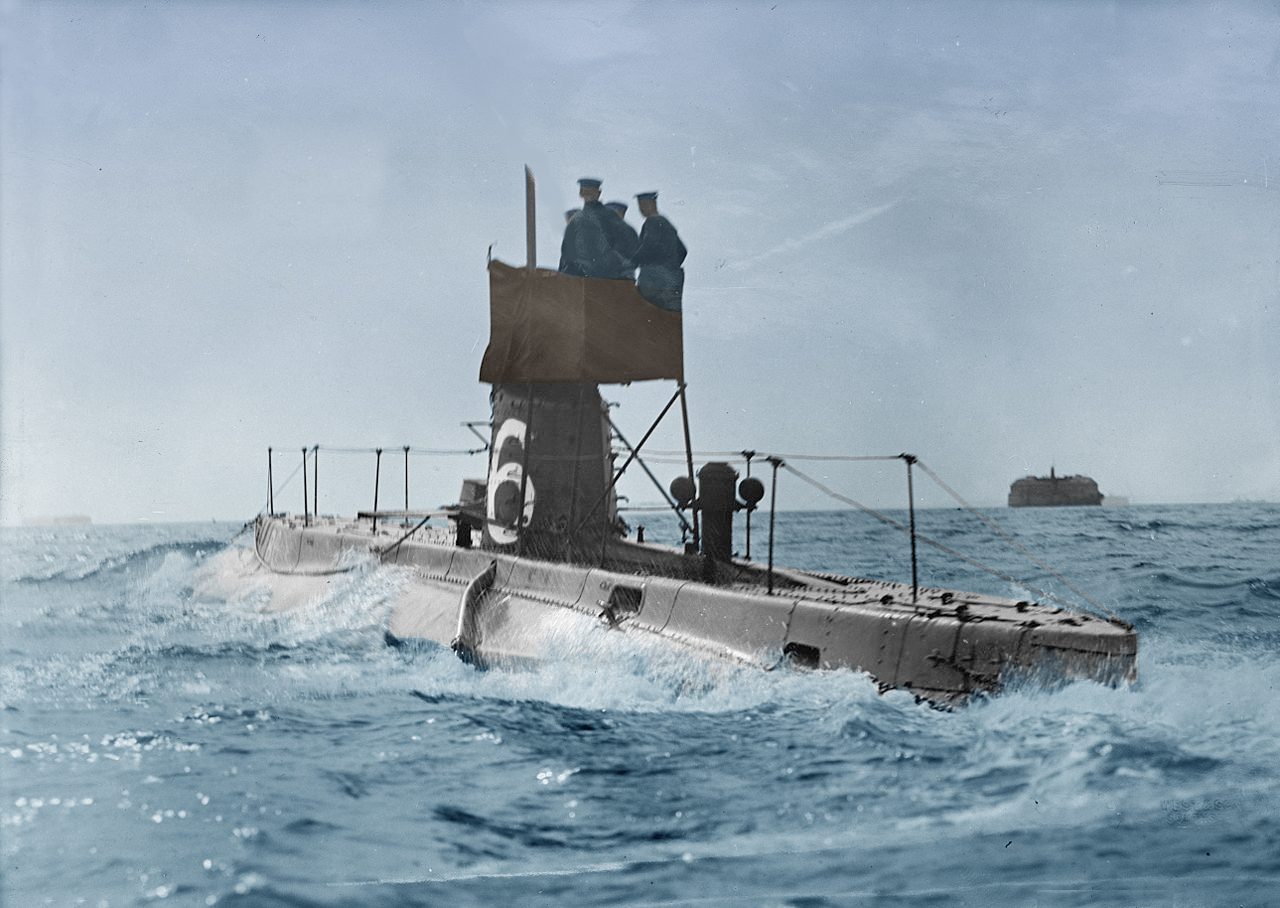
Development
Design of the class

The B-class boats were similar in design to the preceding A class and intended for coastal patrol work. The boats had a petrol engine for surface propulsion and batteries for underwater propulsion. The design was intended to overcome the limitations of speed, endurance and seakeeping that affected the boats of the A class, and the boats were substantially larger than the earlier class. The B-class submarines were 142 feet 2.5 inches (43.3 m) long overall. They had a beam of 12 feet 7 inches (3.8 m) and a draught of 11 feet 2 inches (3.4 m). They displaced 287 long tons (292 t) on the surface and 316 long tons (321 t) submerged. The boats were over 40 feet (12.2 m) longer, slightly wider, and displaced more than 120 long tons (122 t) more than the older boats. Their additional size increased their buoyancy and made them far less liable to unexpectedly plunge beneath the surface in bad weather. The addition of a deck casing above the hull also improved their seakeeping abilities.
Diving planes were initially only fitted at the stern, but additional planes were mounted on the conning tower during construction of B1, B2, and B3; B4 was not fitted with them and it is uncertain if the remaining boats received them during construction. These greatly improved the boats’ depth-keeping, surfacing and diving abilities compared to the A-class boats. These were later exchanged for bow planes; the last boat to receive them was B6, which did not get hers until January 1916. The B-class submarines lacked any internal bulkheads which exposed the crew to the petrol engine’s exhaust fumes. Mice were used to detect any concentrations of carbon monoxide inside the hull. Ventilation was provided for the batteries, but none for the crew’s living area. No accommodations were provided for the crew and they were forced to improvise while at sea. In recognition of this issue, the crew’s endurance was only expected to be four days during the summer and three days during the winter.
Hull and general design
The submarines’ hulls were tested to a nominal depth of 100 feet (30.5 m) by filling the hull with water and subjecting it to a pressure of 35 psi (241 kPa; 2 kgf/cm2), but the maximum operational depth was considered to be 50 feet (15.2 m). Nonetheless several boats safely dived to 95 feet (29.0 m) during World War I. It took about three minutes to dive the boat due to the shape of the boat and that it could dive out of control if water was pumped into the ballast tanks too quickly.[5] Submerged endurance was officially considered to be 10 hours, but several boats were submerged for 16 hours during the war.
Powerplant
The B-class submarines had a single 16-cylinder petrol engine that had a designed output of 600 horsepower (450 kW) and drove a single propeller. This engine was developed by Vickers from the 450-horsepower (340 kW) Wolseley engine used in the A class. Submerged the submarine used an electric motor powered by 159 battery cells at a working voltage of only 100 volts. This originally lasted only three hours and 45 minutes at full speed, but this time was continually increased over the career of the boats as more powerful batteries were fitted.
On the surface the petrol engine gave a top speed of 12 knots (22 km/h; 14 mph) while the maximum speed submerged was 6.5 knots (12.0 km/h; 7.5 mph). This was about the same speed surfaced as the older submarines, but the B-class boats were about 1 knot (1.9 km/h; 1.2 mph) slower underwater. They carried a maximum of 15.5 long tons (16 t) of petrol that provided a range of 740 nautical miles (1,370 km; 850 mi) at a speed of 8.7 knots (16.1 km/h; 10.0 mph).
Armament
The B-class boats were armed with a pair of 18-inch (457 mm) torpedo tubes side by side in the bow and angled slightly downwards. Space was provided for a pair of reloads, but the addition of extra equipment over the years meant that they could only be carried if an equivalent weight of fuel was discarded.[7] By the start of World War I the boats could carry the 18-inch Mark VIII torpedo which had two speed and range settings. At 35 knots (65 km/h; 40 mph) the torpedo had a range of 2,500 yards (2,300 m), but a range of 4,000 yards (3,700 m) at 29 knots (54 km/h; 33 mph). It had a warhead that consisted of 320 pounds (150 kg) of TNT.
⚙ specifications |
|
| Displacement | 287 long tons surfaced, 316 long tons (321 t) submerged |
| Dimensions | 142 ft 2.5 in x 12 ft 7 in x 11 ft 2 in (43.3 x 3.8 x 3.4 m) |
| Propulsion | On 16-cyl. Vickers 600 bhp petrol, 1× EM 180 hp (130 kW) electric |
| Speed | 12 kn (22 km/h; 14 mph) surfaced, 6.5 kn (12.0 km/h; 7.5 mph) submerged |
| Range | 1,000 nmi (1,900 km; 1,200 mi) at 8.7 kn (16.1 km/h; 10.0 mph) surfaced |
| Armament | 2 × 18 in (450 mm) bow torpedo tubes |
| Test depth | 100 feet (30.5 m) |
| Crew | 15 |
Combat Records
In mid-1912 most of the B-class submarines were transferred to the Mediterranean. B6, B7, and B8 were sent to Gibraltar while B9, B10 and B11 sailed for Malta. B1, B2, B3, B4, and B5 remained in the United Kingdom, the latter four assigned to the 3rd Submarine Flotilla. During exercises in October 1912 off Dover with the 6th and 7th Torpedo Boat Flotillas B2 was rammed amidships by the German passenger liner SS Amerika on 4 October 1912. Cut nearly in half, she sank almost immediately and only one man was rescued by the submarine C16.
By the beginning of World War I, B3, B4, and B5 were at Dover and were deployed on a line between Calais and the Goodwin Sands to protect the passage of the British Expeditionary Force to France. Each submarine would sail from Dover before dawn to be secured at the buoy marking their billet at dawn, the idea being that they would be able to slip from the buoy when they spotted an enemy ship and manoeuvre to attack. That this was not a good tactic was proved when B3 narrowly avoided a torpedo from a German U-boat on the morning of 2 October. Nonetheless the scheme was successful and the BEF crossed to France without loss.
B1 remained at Portsmouth for local defence and training duties through 1916 before being paid off. B3 and B4 were transferred to Ardrossan by the end of 1915 to relieve two even more obsolescent A-class boats on local defence duties in the Firth of Clyde. B3 was transferred to Leith during mid-1916 where she was fitted with an experimental hull-mounted directional hydrophone system and later sent to Rosyth in 1917 where she was used as either a target to train anti-submarine forces or experimental work for the rest of the war. B4 was paid off before the end of 1916. B5 moved to Portsmouth during 1915 where she too was paid off before the end of 1916.
Mediterranean:
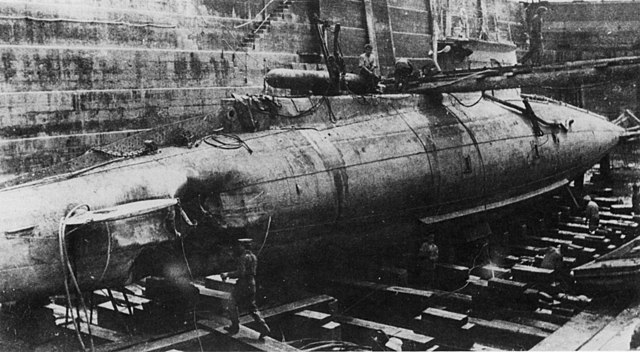
The three Malta-based boats were sent to the Dardanelles in mid-September 1914 to prevent a sortie by the German battlecruiser SMS Goeben and the light cruiser SMS Breslau into the Eastern Mediterranean. The entrance to the Dardanelles was patrolled from dawn to dusk by these boats as well as four French submarines which arrived later. Neither the British nor the French submarines had enough battery power or underwater speed to combat the south-flowing currents in the Dardanelles to reach the Sea of Marmara, but B11 was selected for a sortie that would attempt to penetrate as far as the town of Chanak, halfway up the Dardanelles, because she had the newest, and thus most powerful, batteries. Special guards were fitted over the forward diving planes to make sure that any mooring wires of mines would not get entangled and dragged down to the boat.
On 13 December 1914, B11, commanded by Lieutenant Norman Douglas Holbrook, entered the Dardanelles in the early morning. Shortly after departure one of the guards broke and began banging against the hull, making a lot of noise and vibration. Lieutenant Holbrook ordered the boat to the surface in an attempt to cut the guard loose even though the boat was in full view of the Turkish guns defending the entrance. They succeeded before dawn revealed their presence to the Turks and proceeded up the Dardanelles at a depth of 80 feet (24.4 m) to avoid the Turkish minefields. Two and a half hours later B11 came to periscope depth and Holbrook spotted the elderly Turkish ironclad Mesudiye.
He fired one torpedo that struck the ship, which settled by the stern and then capsized. Before sinking, Mesudiye spotted B11 and fired on her periscope which revealed her position to the shore batteries. Attempting to leave the area, B11 briefly grounded herself, breaking the surface, but was able to get herself off. B11’s compass became fogged and prevented the submarine from navigating at depth; instead Holbrook had to con the boat at periscope depth which meant he had to go through the minefields, not below them. Nevertheless, the boat made it back safely; Holbrook was awarded the Victoria Cross, his First Lieutenant, the Distinguished Service Order and every enlisted man the Distinguished Service Medal.
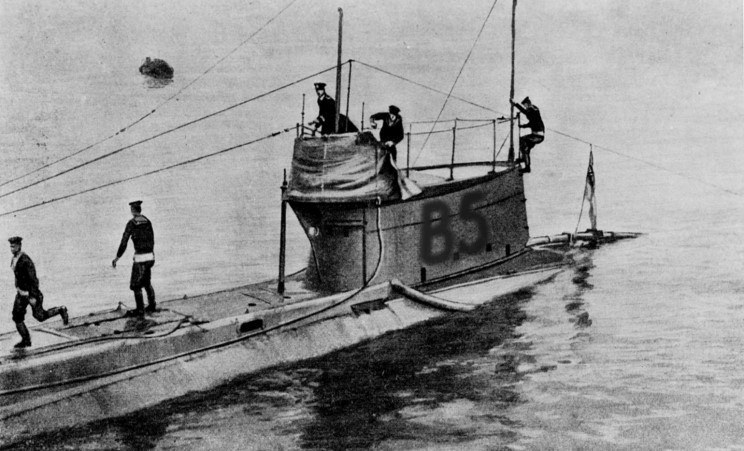
B6 and B8 arrived from Gibraltar in mid-February 1915 as did B7 a month later. Other, more modern submarines followed, and several attempts were made to reach the Sea of Marmara. The British submarine E15 ran aground in April during one of these attempts and had to be abandoned. B6 was sent to destroy her with torpedoes to prevent the Turks from salvaging her. One of the torpedoes hit a barge alongside and the other torpedo missed. After running out of fuel it drifted down the Dardanelles and was recovered by the destroyer Scorpion which returned it to B6. B11 attempted again the following day, but was thwarted by fog.
The B-class boats were deemed redundant once more capable submarines arrived in early 1915 and most returned to Malta. B6 and B11, however, were sent to Alexandria where they conducted patrols along the Libyan coast to prevent arms deliveries to rebellious tribesmen. During one incident on 16 August 1915 a party of Arabs and officers in European uniforms were spotted displaying a flag of truce. The two submarines anchored and Lieutenant Holbrook was rowed ashore to talk to them. They opened fire, killing one man and wounding three, including Holbrook. The submarines were soon withdrawn from this task as they were totally unsuitable for this duty, lacking any deck armament at all.
Adriatic waters
In September 1915, after the Italian declaration of war on the Central Powers, the transfer of the B-class boats to the Adriatic was suggested by the Admiralty. Originally they were to be based at Brindisi, but this was changed to Venice as there were already 14 British and French submarines based at Brindisi. B4, B7, and B9 were the first to arrive, but B4 collided en route with the Italian tug escorting them and required immediate docking upon her arrival. B9 made the first patrol on 18 October and a total of 81 patrols were made by the B-class submarines before they ceased in October 1916. Nothing of note was directly accomplished by the submarines, but they fulfilled the ultimate goal of keeping the Austro-Hungarians from attacking the Italian coast.
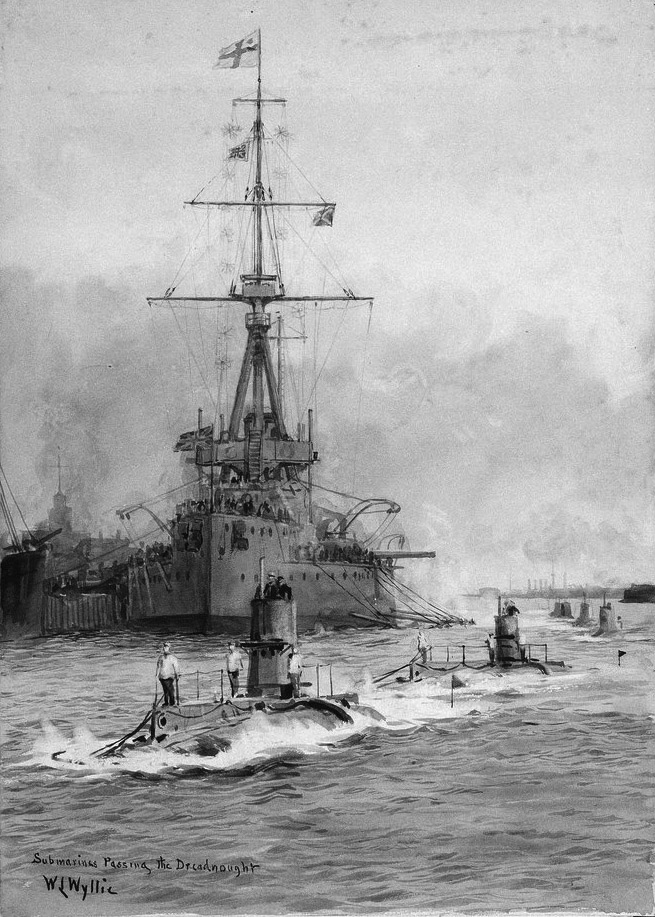
B11, now commanded by Lieutenant Gravener, encountered an Austro-Hungarian seaplane on 11 November that had been forced down by engine trouble. B11 attempted to engage the seaplane with the one Maxim gun she had aboard, but it jammed almost immediately and Gravener attempted to ram the aircraft. The Austrians managed to restart their engine, however, and flew off, easily avoiding Gravener’s ramming attempt. On 17 January B11 encountered another seaplane with engine trouble. This time the Austrians were unable to repair their engine and were captured. B9 was spotted by an Austrian seaplane on 29 March and eventually forced to dive after both sides failed to damage each other with machine gun fire.
B7 had a narrow escape off the Austrian naval base at Pola three months later when she was damaged by another seaplane that jammed her diving planes in the “hard to rise” position which meant she could not submerge until they were repaired. Both B8 and B11 were missed by torpedoes fired by Austrian submarines in early 1916. On one patrol the gear teeth of B11’s steering mechanism were stripped which made the rudder loose and the boat unsteerable. Relieving tackles were rigged, despite the heavy seas, but they parted under the strain after 15 minutes. Slowly the boat began to drift towards the enemy coast, but a northwesterly breeze sprang up before dawn and the seas moderated which allowed her to make about 3 knots (5.6 km/h; 3.5 mph) by going astern. By this time she was overdue and the Italians began to search for her. She was towed back to Venice by an Italian destroyer that found her about mid-morning.
B10 became the first submarine sunk by air attack when she was sunk at her mooring in Venice on 9 August 1916 after a near-miss during an Austrian air raid. The bomb blew a hole about 6 feet (1.8 m) in diameter in her pressure hull. She was re-floated, but a fire gutted her while she was under repair and she was sold for scrap.
The B-class boats had reached the limits of their usefulness and the survivors were withdrawn to Malta on 30 October where they were paid off pending a decision on their fate. In August 1917 the boats were converted at Malta to surface patrol boats with a raised wheelhouse, given a 3-inch (76 mm) 12-pounder gun and renamed S6 to S9, and S11. They were assigned to patrol the Otranto Barrage, but their age and small size worked against them and they were soon paid off at Malta where they were sold after the war.
Read More/Src
Books
Akermann, Paul (2002). Encyclopaedia of British Submarines 1901–1955 (reprint of the 1989 ed.). Periscope Publishing.
Gardiner, Robert & Gray, Randal, eds. (1985). Conway’s All the World’s Fighting Ships 1906–1921. NIP
Harrison, A. N. (January 1979). “The Development of HM Submarines From Holland No. 1 (1901) to Porpoise (1930) (BR3043)”. Barrow in Furness Branch.
Kemp, Paul & Jung, Peter (1989). “Five Broken Down B Boats: British Submarine Operations in the Northern Adriatic 1915–1917”.
Wilson, Michael (1981). “The British ‘B’ Class Submarine”. Roberts, John (ed.). Warship Volume V. Conway Maritime Press.
Links
britsub.net Generic
rnsubs.co.uk/ B class
en.wikipedia.org/ British B class submarine
commons.wikimedia.org British B class submarines
Model Kits
OKB Grigorov B class submarine
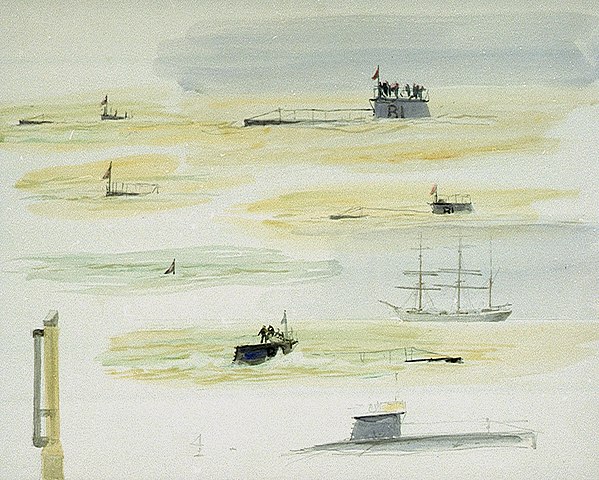
3D
 B1
B1
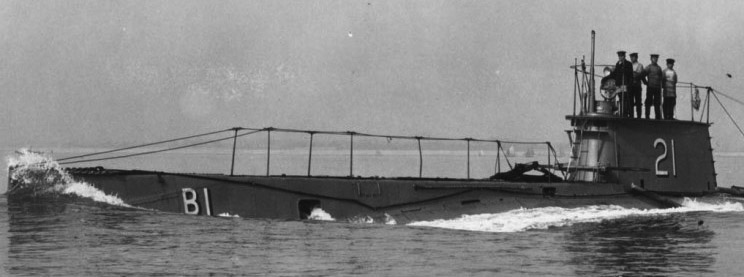
Was laid down as A.14. Peacetime. Spent the First World War in Home waters under Lt. Basil Beal, where it helped screen the movement of the British Expeditionary Force to France in August 1914. The operational career of the boat in home waters was brief and none of the ‘B’ Class which were operating in home waters was on active service by the end of 1916. By this time they were being used for training, experimental duties or paid off. Sold August 1921.
 B2
B2

Lt. P.B. O’Brien. Based on the depot ship HMS Fort. She was Rammed and sunk by SS Amerika off Dover 4th October 1912, one survivor, Lt. R.I. Pulleyne.
 B3
B3

Commissioned 19th January 1906. Commander 1914, Lt. Cdr. A. C. R. Bennett. Lt. Chisholm. 1914-1915 Harbour Defence Flotilla, Dover. 1915-1916 Ardrossan, Home waters along with B.1 suffered much the same fate. Sold December 1919.
 B4
B4
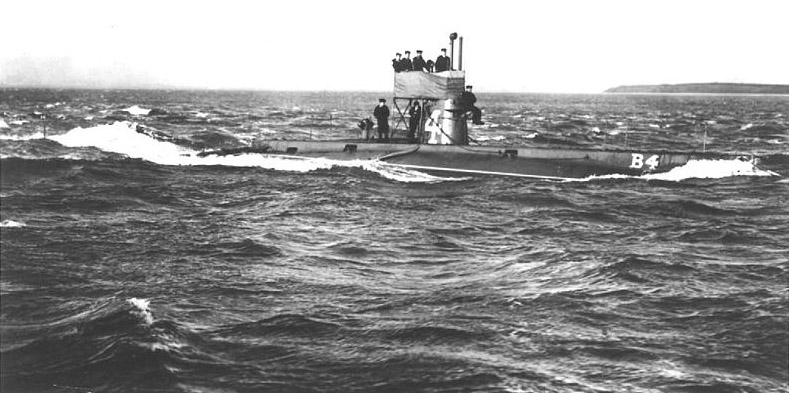
Commissioned 28th January 1906. Served in Home water along with B.1 and B3 also relegated to training or experimental duties. Sold April 1919.
 B5
B5
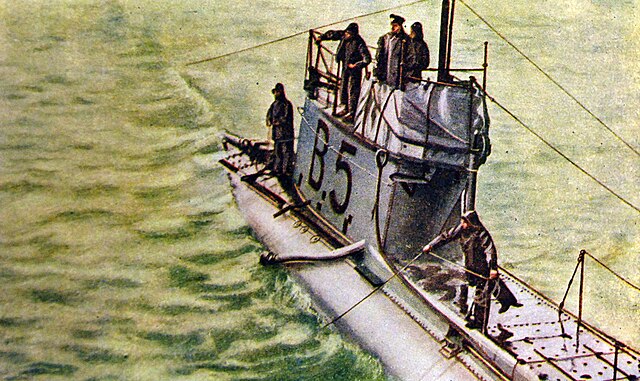
Commissioned 25th February 1906. Commander 1915 – 1916 Lt. O. Hallifax. She served in Home waters in Fort Blockhouse. Sold August 1921.
 B6
B6
Commissioned 3rd March 1906. Commander 1915 Lt. R.E. Birch and MacArthur. She was stationed in the Adriatic Squadron – 1915. Marco Polo, Venice, Hindu Kush at Mudros, Lemnos.
With her sisters up to the B11 she served in the Mediterranean. Was sent to Venice to assist the Italians to patrol the main Austrian base at Pola in October 1915. These boats carried out 81 patrols in a period of just over a year. Made an unsuccessful attempt to sink E15 after she had run aground whilst trying to enter the Sea of Marmara.
Converted to surface patrol craft August 1917 and renamed S6 for service on the Otranto Barrage.
 B7
B7
Commissioned 27th March 1906. Commander 1916 Lt. Thomas Ouchterlony, Commander 1917 Lt. North. Based on the Adriatic Squadron – 1915. Marco Polo, Venice. Converted to Surface Patrol Craft and renamed ‘S7’ for service on the Otranto Barrage. Attacked by Austrian aircraft during June of 1916. The Commanding Officer was so badly affected by this attack that he never went to sea in a submarine again. Sold October 1919 and scrapped in Malta.
 B8
B8
Commissioned 10th April 1906. Commander 1916 Lt. E. Tufnell. Service Career Adriatic Squadron – 1915. Marco Polo, Venice. Served in the Mediterranean and was also sent to Venice. Converted to Surface Patrol Craft and renamed ‘S8’ for service on the Otranto Barrage. In 1916 B8 was shot at and luckily missed by U-XI (Ex German UB-15). Sold 1919.
 B9
B9
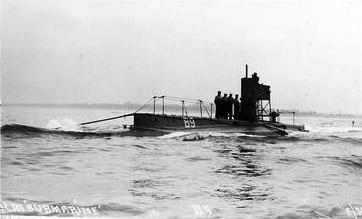
Commissioned 28th April 1906. Cdr 1914 Lt. Warburton. Cdr 1915-16 Lt. Jermyn Rushbrooke. In 1914 she was in Tenedos. In 1915 she was reassigned to the Adriatic Squadron. Dardanelles Flotilla.
Marco Polo station in Venice and Hindu Kush station at Mudros, Lemnos. Transferred to Venice on Marco Polo. Converted to Surface Patrol Craft and renamed ‘S9’ for service on the Otranto Barrage.
Attacked by Austrian aircraft on 29th March 1916. Sold 1919 and scrapped in Italy.
 B10
B10
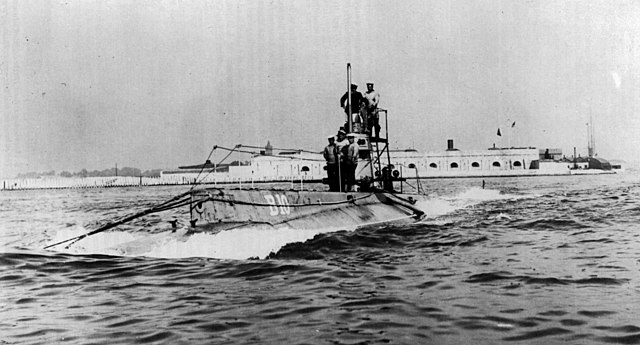
Commissioned 31st May 1906. Commander 1914 Lt. Gravenor. Cdr 1916 Lt. K. Michell. In 1914 she was in Tenedos. Adriatic Squadron in 1915, Dardanelles Flotilla. Later based in Marco Polo, Venice and Hindu Kush station at Mudros, Lemnos. Was in Venice along with B.6 and B.8. First submarine to be sunk by aircraft. Returned from patrol, and berthed alongside the depot ship Marco Polo, she was found to have sunk after an air raid. She was salvaged and placed in dock for repairs. A fire was started by an Italian using cutting gear near one of B.10’s petrol tanks which remained unemptied. The dock was flooded, whether by accident, panic or design and the destruction of the boat was complete. She unsuccessfully attacked an Austrian merchant ship in June of 1916.
Sunk during an air raid on Venice 9th August 1916, raised and sold to the Italian government for scrap.
 B11
B11
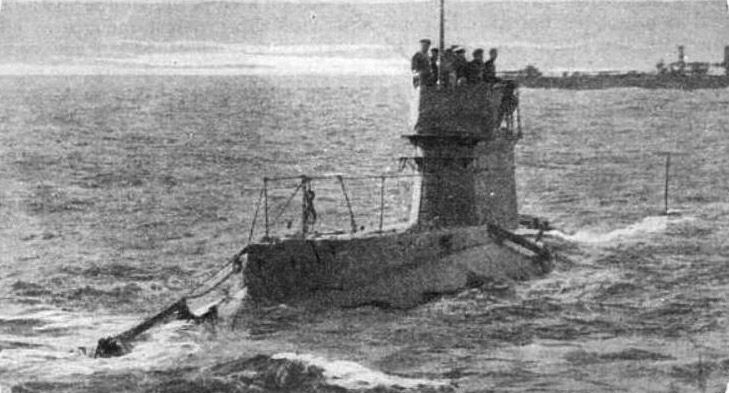
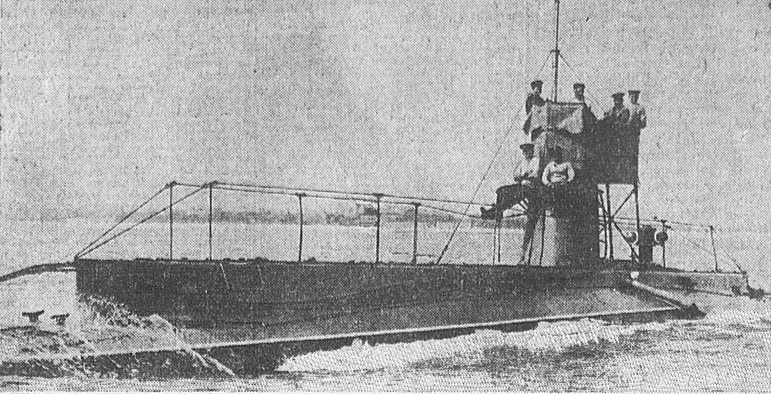
Commissioned 11th July 1906. Lt. Basil Beal in 1914, Lt. Holbrook 1915, Lt. Norman Holbrook, Lt. S. Gravener, Lt. F. Kennedy. In 1914 she was based in Tenedos, Adriatic Squadron in 1915, Dardanelles Flotilla. Marco Polo, Venice Hindu Kush at Mudros, Lemnos. Sailed from Tenedos on 12th December 1914 in an attempt to break into the Sea of Marmara. She was the first British submarine to attempt to force her way into the Sea of Marmara. She not only succeeded in doing so but also sank the battleship Messudieh from a range of some 800 yards. This was an incredible feat for a submarine which was designed for coastal work.
Holbrook was awarded the first submarine VC of the war, his First Lt, Lt. S. T. Winn the DSO and the remainder of the crew were awarded either the DSC or DSM. Also made an unsuccessful attempt to sink E15 after she had run aground trying to enter the Sea of Marmara. She also scored a first when capturing the crew of the Austrian flying-boat L59 which had been forced down whilst experiencing engine trouble during January of 1916. Converted to Surface Patrol Craft and renamed ‘S11’ for service on the Otranto Barrage. Sold 1919 and scrapped in Italy.
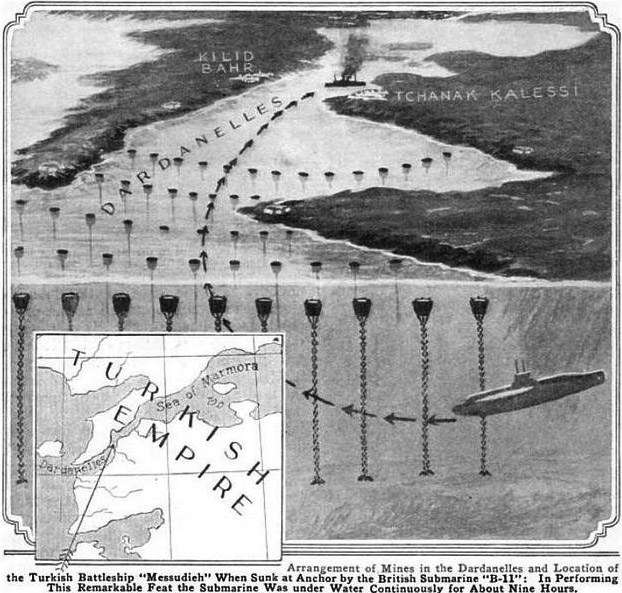


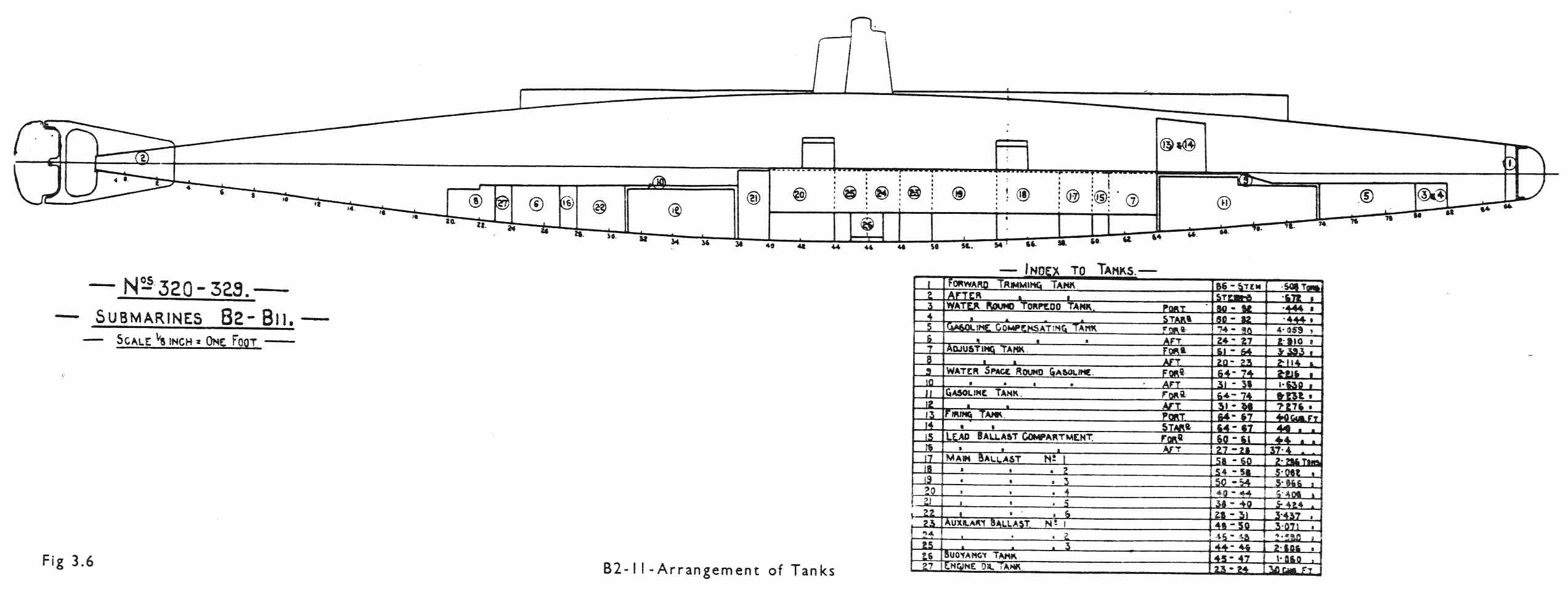

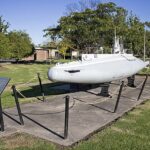
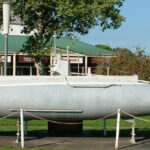
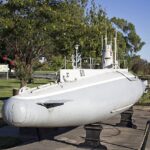
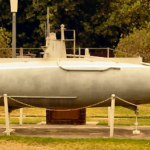
 Latest Facebook Entry -
Latest Facebook Entry -  X(Tweeter) Naval Encyclopedia's deck archive
X(Tweeter) Naval Encyclopedia's deck archive Instagram (@navalencyc)
Instagram (@navalencyc)





 French Navy
French Navy Royal Navy
Royal Navy Russian Navy
Russian Navy Armada Espanola
Armada Espanola Austrian Navy
Austrian Navy K.u.K. Kriegsmarine
K.u.K. Kriegsmarine Dansk Marine
Dansk Marine Nautiko Hellenon
Nautiko Hellenon Koninklije Marine 1870
Koninklije Marine 1870 Marinha do Brasil
Marinha do Brasil Osmanlı Donanması
Osmanlı Donanması Marina Do Peru
Marina Do Peru Marinha do Portugal
Marinha do Portugal Regia Marina 1870
Regia Marina 1870 Nihhon Kaigun 1870
Nihhon Kaigun 1870 Preußische Marine 1870
Preußische Marine 1870 Russkiy Flot 1870
Russkiy Flot 1870 Svenska marinen
Svenska marinen Søværnet
Søværnet Union Navy
Union Navy Confederate Navy
Confederate Navy Armada de Argentina
Armada de Argentina Imperial Chinese Navy
Imperial Chinese Navy Marinha do Portugal
Marinha do Portugal Mexico
Mexico Kaiserliche Marine
Kaiserliche Marine 1898 US Navy
1898 US Navy Sovietskiy Flot
Sovietskiy Flot Royal Canadian Navy
Royal Canadian Navy Royal Australian Navy
Royal Australian Navy RNZN Fleet
RNZN Fleet Chinese Navy 1937
Chinese Navy 1937 Kriegsmarine
Kriegsmarine Chilean Navy
Chilean Navy Danish Navy
Danish Navy Finnish Navy
Finnish Navy Hellenic Navy
Hellenic Navy Polish Navy
Polish Navy Romanian Navy
Romanian Navy Turkish Navy
Turkish Navy Royal Yugoslav Navy
Royal Yugoslav Navy Royal Thai Navy
Royal Thai Navy Minor Navies
Minor Navies Albania
Albania Austria
Austria Belgium
Belgium Columbia
Columbia Costa Rica
Costa Rica Cuba
Cuba Czechoslovakia
Czechoslovakia Dominican Republic
Dominican Republic Haiti
Haiti Hungary
Hungary Honduras
Honduras Estonia
Estonia Iceland
Iceland Eire
Eire Equador
Equador Iran
Iran Iraq
Iraq Latvia
Latvia Liberia
Liberia Lithuania
Lithuania Mandchukuo
Mandchukuo Morocco
Morocco Nicaragua
Nicaragua Persia
Persia San Salvador
San Salvador Sarawak
Sarawak Uruguay
Uruguay Venezuela
Venezuela Zanzibar
Zanzibar Warsaw Pact Navies
Warsaw Pact Navies Bulgaria
Bulgaria Hungary
Hungary

 Bundesmarine
Bundesmarine Dutch Navy
Dutch Navy Hellenic Navy
Hellenic Navy Marina Militare
Marina Militare Yugoslav Navy
Yugoslav Navy Chinese Navy
Chinese Navy Indian Navy
Indian Navy Indonesian Navy
Indonesian Navy JMSDF
JMSDF North Korean Navy
North Korean Navy Pakistani Navy
Pakistani Navy Philippines Navy
Philippines Navy ROKN
ROKN Rep. of Singapore Navy
Rep. of Singapore Navy Taiwanese Navy
Taiwanese Navy IDF Navy
IDF Navy Saudi Navy
Saudi Navy Royal New Zealand Navy
Royal New Zealand Navy Egyptian Navy
Egyptian Navy South African Navy
South African Navy






























 Ukrainian Navy
Ukrainian Navy dbodesign
dbodesign